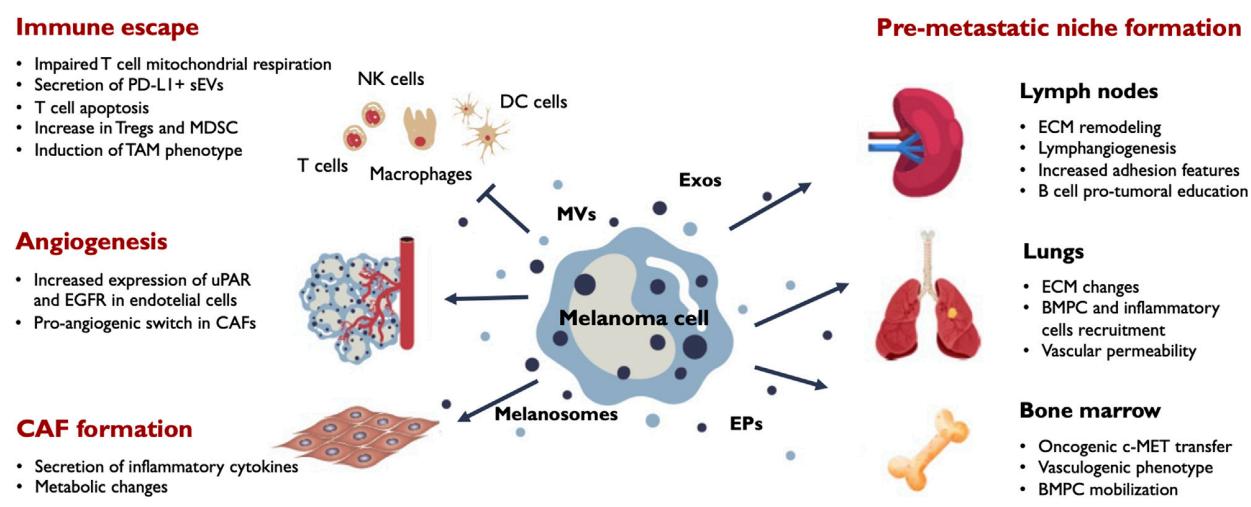Melanoma Tissue Exosome Research and Application
Melanoma is a malignant neoplastic disease with high aggressiveness and mortality. Early diagnosis and surgical resection have a positive prognosis, but the lack of effective treatment for metastasis drastically reduces the survival rate. Numerous studies have demonstrated the involvement of melanoma tissue exosomes in melanoma development, progression, and immune escape. Creative Biolabs provides services for research and applications related to melanoma tissue exosomes to help clients better understand the relationship between exosomes and melanoma.
Melanoma Exosomes Increase the Risk of Disease
The progressive evolution of melanoma includes altered melanocyte gene expression leading to unlimited cell growth and increased invasiveness, the release of various cytokines such as chemokines and growth factors to promote tumor angiogenesis and extracellular matrix remodeling to facilitate tumor cell invasion, and all these steps are associated with exosomes. For example, miR-222 overexpression in exosomes can both inhibit various anti-cancer targets (e.g., p27Kip1) and activate various signaling pathways including PI3K/AKT pathway to promote melanoma development. The miRNA let-7 family members (e.g. let-7a, let-7b) and miR-182 in exosomes are also involved in the development of melanoma. Elevated let-7a enhanced migration and invasiveness by regulating integrin β-3 expression, while downregulation of let-7b led to elevated expression of cyclins D1, D3, and Cdk4 to promote melanoma growth and proliferation. miR-182 activated melanoma oncogenicity through anchoring non-dependent growth and motility of the extracellular matrix, while down-regulation of microphthalmia-associated transcription factor expression promoted melanoma cell migration and survival. In addition, matrix metalloproteinases and urokinase fibrinogen activators carried by exosomes promote the degradation of extracellular matrix components, creating conditions for melanoma cell invasion and adhesion, while the interaction of specific molecular components in the contents, such as CD44 and α6β4, with laminin, collagen, and fibronectin in the matrix also contributes to the adhesion of melanoma cells.
Melanoma Exosomes Promote Tumor Metastasis
Melanoma exosomes promote tumor metastasis on the one hand by mediating the transmission of melanoma metastatic properties. Highly metastatic B16 melanoma exosomes can be taken up by low metastatic melanoma cells and transformed into highly metastatic tumor cells with the ability to form large numbers of metastatic tumor lung colonies. This may be related to the specific invasive miRNAs and differentially expressed exosomal proteins in melanoma cell exosomes. On the other hand, melanoma exosomes promote melanoma metastasis by promoting melanoma EMT (epithelial-mesenchymal transition), pre-metastatic ecological site preparation, and tumor cell homing. Melanoma exosomes regulate EMT-like processes mainly through the targeting of certain protein targets by miRNAs in the contents (e.g. miR let-7i, miR Let-7a, miR-200a, miR-191, miR-23a) and the activation of exosome-induced MAPK signaling pathway molecules (e.g. MAP3K4, MAP2K5, and MAPK13). Meanwhile, melanoma exosomes in lymph nodes can induce the expression of various pro-angiogenic factors in the nodes, and they also have their pro-angiogenic effects. Melanoma exosomes induce the activation of various molecules such as MAPK 14, uPA, collagen 18, and laminin 5 derivatives in the stroma of sentinel lymph nodes, which remodel the intra-nodal stroma and facilitate the invasion of melanoma cells, creating favorable conditions for the preparation of pre-metastatic ecological sites. In addition, melanoma exosomes can recruit melanoma cells to the sentinel lymph nodes, which may be related to the recruitment of melanoma cells by certain molecules they carry.
Melanoma Exosomes Suppress Immunity
Melanoma tissue exosomes not only increase FAS levels in CD4+ T cells and kill CD4+ T cells through the interaction of their surface FASL with FAS on the surface of CD4+ T cells but also down-regulate anti-apoptotic proteins (such as BCL-2, BCL-xL, and MCL-1) in T cells through the microRNAs they carry. This activates the mitochondrial apoptosis pathway in CD4+ T cells, which induces apoptosis. CD8+ T cells can also be induced into apoptosis by melanoma exosomes through FASL/FAS signaling.
 Fig.1 Main outcomes of EV release in melanoma progression. (Benito-Martín, 2023)
Fig.1 Main outcomes of EV release in melanoma progression. (Benito-Martín, 2023)
Exosomes as signaling carriers are involved in melanoma progression, metastasis, and immunomodulation through multiple pathways. Melanoma tissue exosomes carry richer and more specific tumorigenic information and can provide a basis for melanoma evaluation by detecting their specific contents. Creative Biolabs has optimized a well-established and stable tissue exosome service system to obtain high-quality exosomes from melanoma tissues for subsequent histological analysis and functional exploration. Please contact us with your interest.
Reference
-
Benito-Martín, A.; et al. Extracellular vesicles and melanoma: New perspectives on tumor microenvironment and metastasis. Front Cell Dev Biol. 2023, 10: 1061982.
For Research Use Only. Cannot be used by patients.
Related Services:

 Fig.1 Main outcomes of EV release in melanoma progression. (Benito-Martín, 2023)
Fig.1 Main outcomes of EV release in melanoma progression. (Benito-Martín, 2023)








